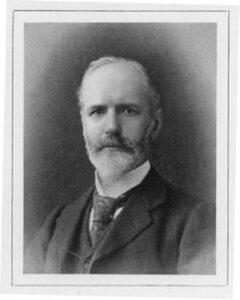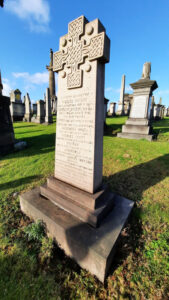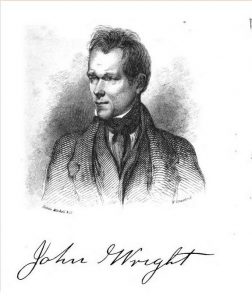by Andrew Mitchell and Morag T Fyfe
Born in Paisley, near Glasgow on 7 June 1772, William Rae Wilson was the eldest son of Patrick Ray and Isabel Wilson, and grandson of William Ray who had been Provost of Haddington in East Lothian in 1738, 1748 and 1752. John Wilson A.M., his other grandfather was buried in Paisley Abbey Churchyard and William was responsible for erecting (or re-erecting) a stone in his memory in 1806.
William’s uncle John Wilson, one of Glasgow’s town clerks, encouraged him to enter the legal profession and William practised as a solicitor for some years. John Wilson died without children in 1806. After making provision for his widow and leaving legacies to his sister Mrs Rae and her children he left the bulk of his fortune to William, including the twelve acre estate of Kelvinbank and other property in Glasgow. William also assumed the name and arms of Wilson by Letters Patent.
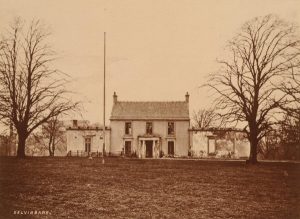
Kelvinbank House photographed By Annan in 1870 eight years before it was demolished.
In 1811, William married Frances ‘Fanny’ Phillips, daughter of a wealthy sugar merchant John Phillips, owner of Stobcross House located south of Kelvinbank closer to the River Clyde. Fanny died childless in November 1812 after a lingering illness which at that date may have been some form of tuberculosis.
Perhaps spurred by grief, William became a writer. He wrote a tribute to Fanny, published in one of the poet Thomas Gisborne’s volumes of “Christian Female Biography”. As he pursued his writing, travel became the focus, and by combining the two William became an early exponent of the travel memoir.
In 1819 he journeyed to the Middle East, a region in which there was growing interest, but which was little understood. He returned in 1822 and was presented to King George IV at a Levee and Drawing room in June of that year. His presentation was sponsored by the Duchess of Kent and when he published the account of his journey in 1823, under the title of Travels in Egypt and the Holy Land, it was dedicated to the Duchess. The book was well-received, a popular success and went through several editions. The second edition of 1824 was published with the addition of A Journey through Turkey, Greece, the Ionian Isles, Sicily, Spain so that his whole journey from Britain and back was recorded. Travels in Egypt and the Holy Land was the most popular of Wilson’s books and ran to four editions.
“We shall never forget the pleasure with which we perused Dr. Wilson’s ‘Travels in Palestine’ when first published,” wrote one review. “The style, though somewhat rugged and careless, is vigorous and energetic; the scriptural quotations are remarkably apposite and instructive; and what is of far greater importance than mere elegance of language, the sentiments are warm and fresh.”
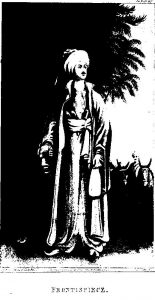
This image is the frontispiece from Travels in Egypt and the Holy Land. It is anonymous but one wonders whether it shows William in native dress during his travels.
William travelled widely through Europe in the following years and recorded his journeys in print. Travels in Norway, Sweden, Denmark, Hanover, Germany, Netherlands was published in 1826, dedicated to the Duke of York, and was followed two years later by Travels in Russia which was dedicated to King George IV. Subsequently he wrote Records of a Route through France and Italy; with Sketches of Catholicism in 1835 dedicated to Queen Adelaide and finally Notes Abroad and Rhapsodies at Home by a Veteran Traveller appeared anonymously in two volumes in 1837.
The Dictionary of National Biography says “He was in some respects a pioneer, his publications had an immediate popularity, and they retain a certain historical interest.” It notes that his writing could be critical of Catholicism – “An upright man, a writer and a distributor of tracts, he was not of a specially tolerant spirit.” Those tendencies may explain perhaps why he was the target of a satirical poem Ode to Rae Wilson Esq. by the English poet, and humourist Thomas Hood in 1837 which ran to over five hundred lines.
On 7 December 1820, William remarried, to Anne Cates, in St George’s Church, Bloomsbury, London and she often accompanied him on his travels. He was elected a Fellow of the Society of Antiquaries of London, in 1822 but had to wait till 1844 before the University of Glasgow awarded him an honorary Doctorate of Law and in turn he bequeathed money to the University for an annual Rae Wilson medal on divinity.
William died in South Crescent, Bedford Square, London on 2 June 1849. His remains were brought to the Glasgow Necropolis and, after a temporary interment in one of the Egyptian vaults there, were placed in a magnificent Moorish style mausoleum tomb in July 1850, with the following inscription.
In Memory of
William Rae Wilson, LL.D.,
Late of Kelvinbank,
Who died 2d June, 1849, aged 76;
Author of
‘Travels in the Holy Land,’
And editor of
Works written in that and other countries
During many years.
‘Thy servants take pleasure in her stones,
And favour the dust thereof.’
This Tablet is inscribed by his affectionate Wife.”
The Wilson family burial place was in the Ramshorn Churchyard but William had arranged for those of his family already buried there to be removed to his new mausoleum in the Necropolis when it was ready. Thus his uncle John Wilson and John’s wife Jane Struthers, his brother John Rae, advocate and his first wife Fanny Phillips all joined him in the Necropolis. In due course Ann Cates was also buried there after her death at Bath on 31 December 1863 aged 82.
While William had no children, his influence flowed down through his wider family. His own nephew – named William Rae Wilson Smith – was a Glasgow councillor noted for his work in improving the city’s health and education. When Mary Louisa Orrock married in New York in 1876 the fact that she was a great grandniece of William Rae Wilson was felt worthy of recording in the newspaper announcements of her marriage.
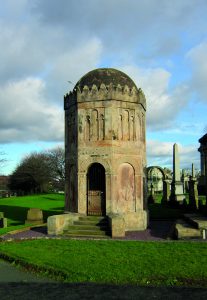
William Rae Wilson’s mausoleum after its recent renovation
Image copyright Ruth Johnston









